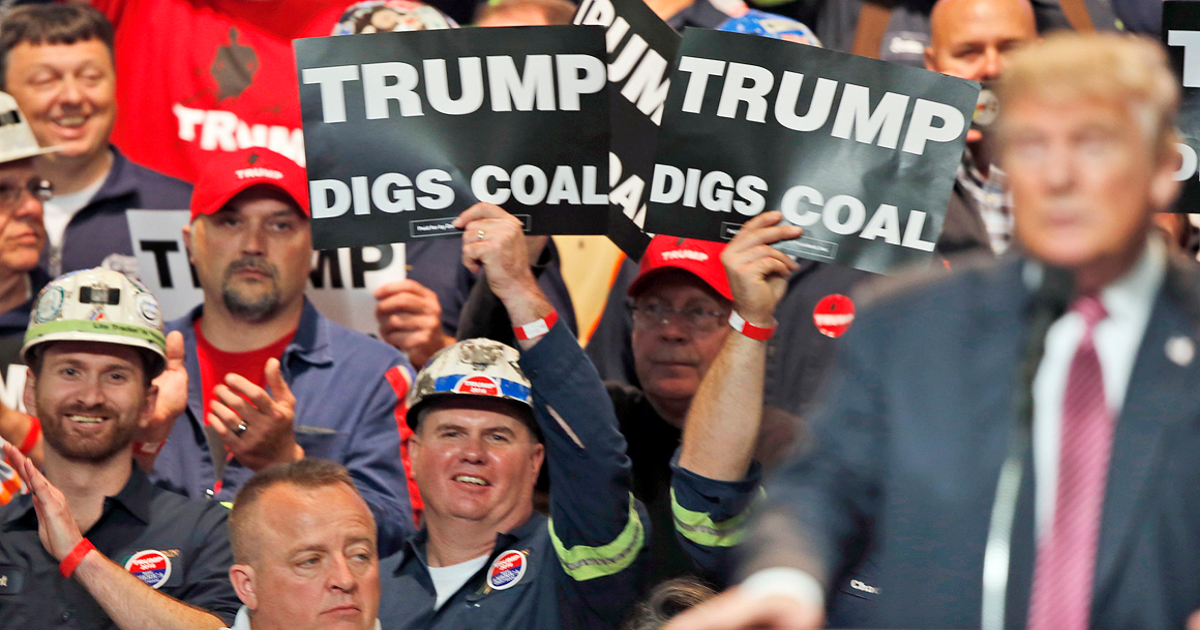
Donald Trump is trying (yet again) to recrown coal king — but the road remains uphill.
The president today announced sweeping executive orders aimed at keeping the geriatric industry alive, including using emergency powers traditionally reserved for wartime to keep open some coal-fired power plants slated for retirement, writes Hannah Northey.
Trump’s moves are far more aggressive than during his first administration.
He is directing federal agencies to prioritize coal leasing on public lands, scrap any policies that shift the nation away from coal, lift barriers to coal mining and exclude coal projects from environmental analyses under the National Environmental Policy Act.
“We’re bringing back an industry that was abandoned,” Trump said today at the White House, lauding “beautiful clean coal.”
Trump’s push is bolstered by fears the country could run out of power to run artificial intelligence data centers, write Peter Behr, Hannah and Jason Plautz. But that may still not be enough to combat market forces and grid operators wary of the president’s capricious policymaking.
“I’m not sure the market is sending the signal right now that coal should actually stick around,” Craig Glazer with PJM Interconnection, the nation’s largest grid operator, said at a recent trade conference.
Coal is by far the dirtiest power source in use. Not only is it a top contributor to climate change, but it’s associated with a plethora of health issues. Coal’s decline in recent years has been linked to a decrease in asthma- and heart-related emergency room visits, in deaths from heart attacks and strokes and in the number of people with blood pressure problems.
Over the past decade, coal has struggled to compete with cheaper natural gas and, more recently, wind and solar power. The cost of compliance with enhanced air pollution standards has also dinged the industry.
But even with relaxed environmental regulations, electric grid operators — who try to plan decades out — may decide it’s not worth making the long-term investment when cleaner, cheaper fuel is available, especially if Trump’s orders don’t last, Glazer said.
That won’t stop the administration from trying. The White House has spent weeks crafting a series of steps to help the industry stay alive long-term, including allowing utilities to seek exemptions from air pollution regulations.
Last week, one of the nation’s dirtiest coal-fired power plants in Montana took the administration up on the offer.
The coal sector is also angling to open up Western land — including the Powder River Basin — for more mining, reestablish the National Coal Council and designate metallurgical coal as a critical mineral.
It’s Tuesday — thank you for tuning in to POLITICO’s Power Switch. I’m your host, Arianna Skibell. Power Switch is brought to you by the journalists behind E&E News and POLITICO Energy. Send your tips, comments, questions to [email protected].
Today in POLITICO Energy’s podcast: Ben Lefebvre breaks down why the oil and gas industry is staying quiet about Trump’s tariffs despite a darkening economic outlook for the sector.

Mike Lee won the energy gavel. Now what?
It’s been more than three months since Mike Lee took control of the Senate Energy and Natural Resources Committee, and colleagues and advocates are still wondering how the Utah Republican will use his perch, writes Kelsey Brugger.
Lee, who has a deeply conservative voting record, has been pushing politically difficult ideas like selling public lands and retooling environmental laws. But he is not known for being a schmoozer or dealmaker.
Trump says EU must pony up $350B
Trump said the European Union must commit to buying $350 billion worth of U.S. energy to secure a tariff reprieve, writes Zoya Sheftalovich.
The president dismissed Brussels’ offer for a “zero-for-zero” tariff agreement on cars and industrial goods. “We have a deficit with the European Union of $350 billion, and it’s gonna disappear fast,” Trump said.
Flooding: After the rain let up, large swaths of the central U.S. face massive river flooding.
Health: The world is heating up. How much can our bodies handle?
Tariff turmoil: Oil prices slumped below $60 as the U.S. plan for China tariffs roiled the outlook.
A showcase of some of our best subscriber content.
Oil shipments to the United States through the original Keystone oil pipeline (no, not that Keystone pipeline) were halted Tuesday after a leak was discovered in North Dakota.
EPA has not made its full draft inventory of greenhouse gas emissions available for public comment, raising questions about whether it will submit the climate pollution report by the deadline in one week.
Canada is on track to build the first commercial small modular nuclear reactor in North America, marking a watershed moment for the advanced nuclear industry.
That’s it for today, folks! Thanks for reading.
